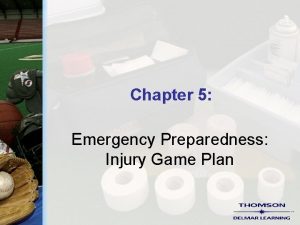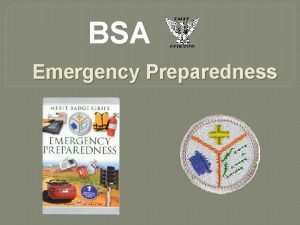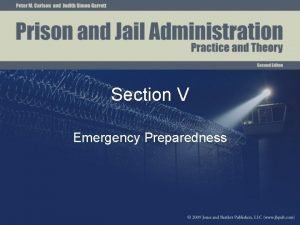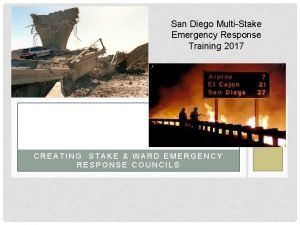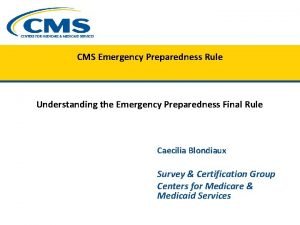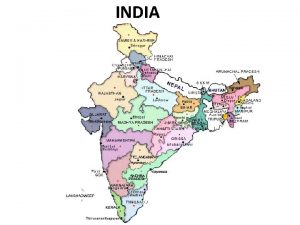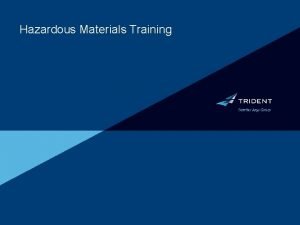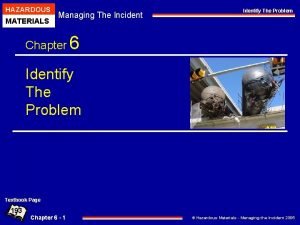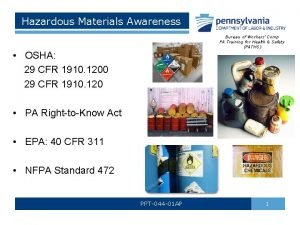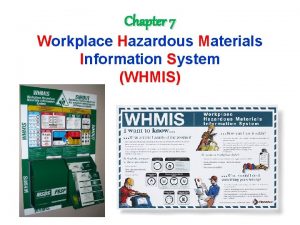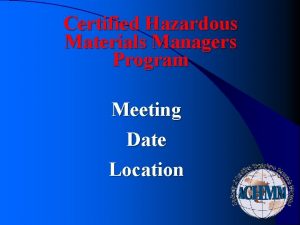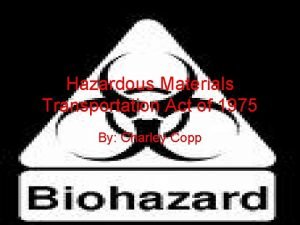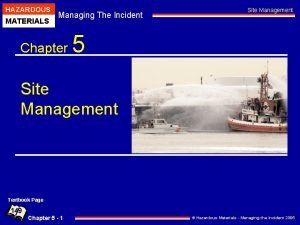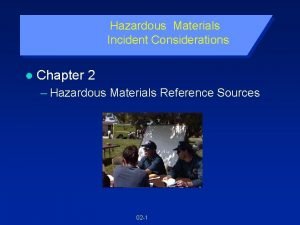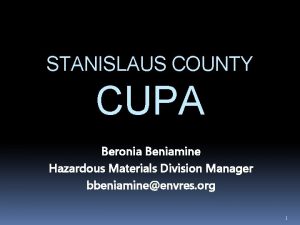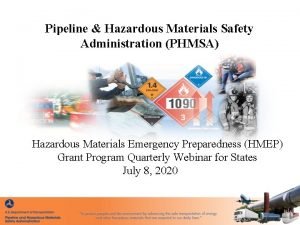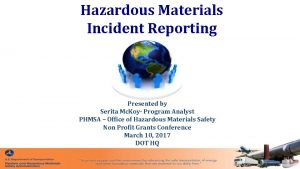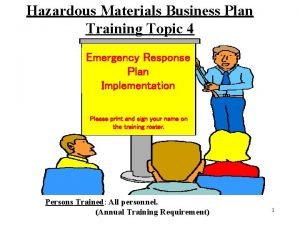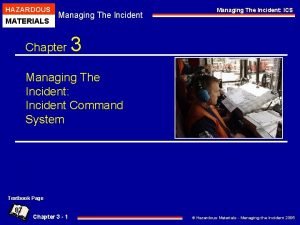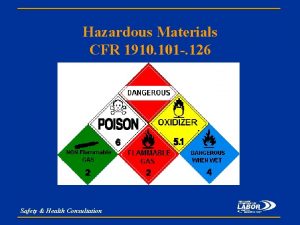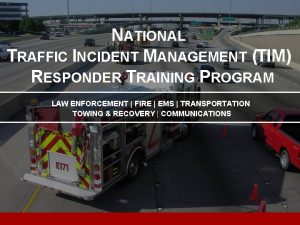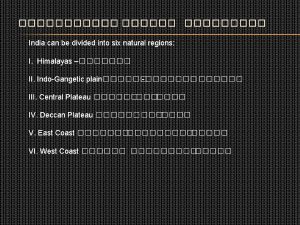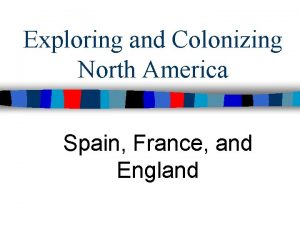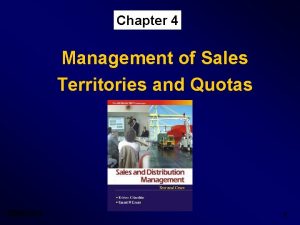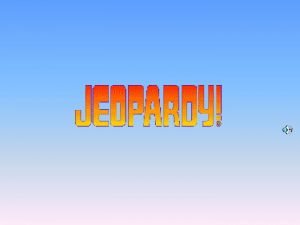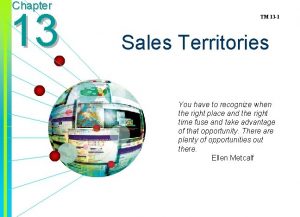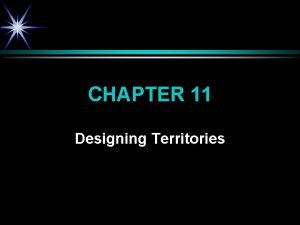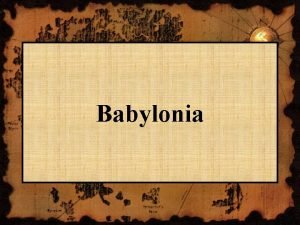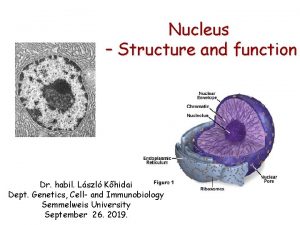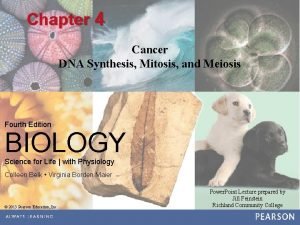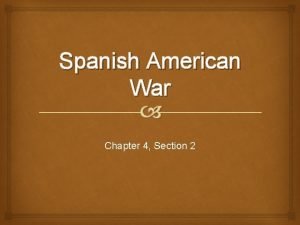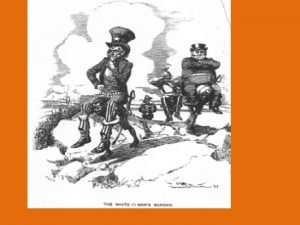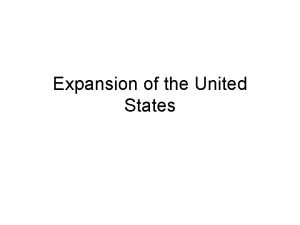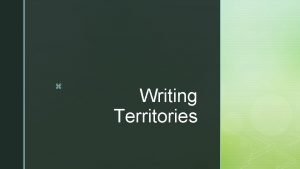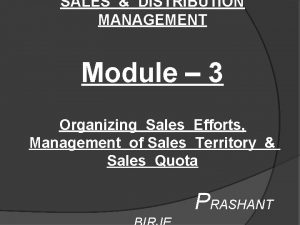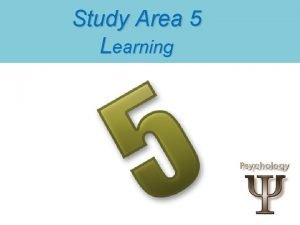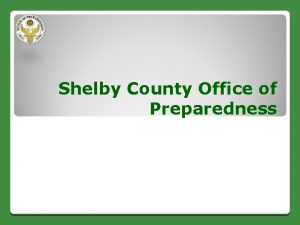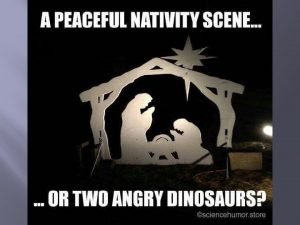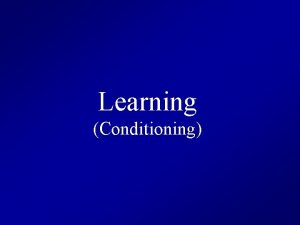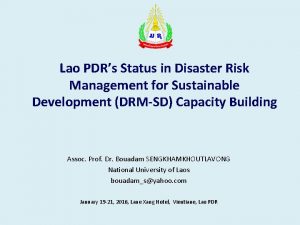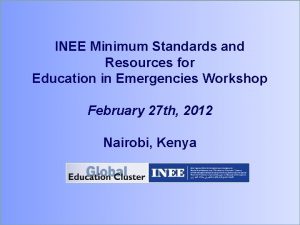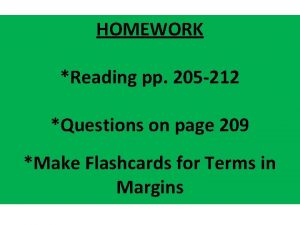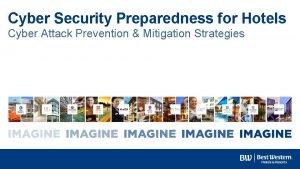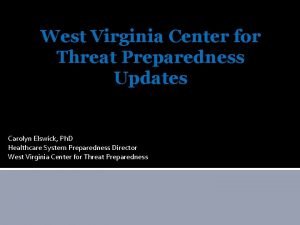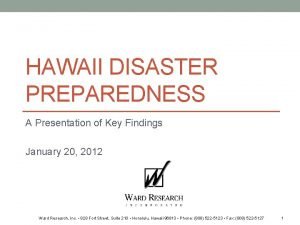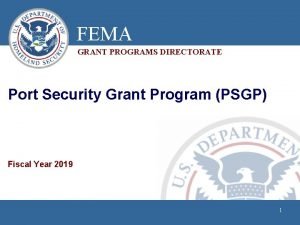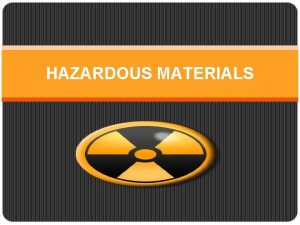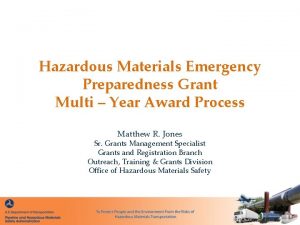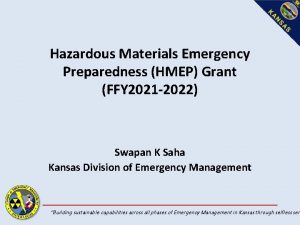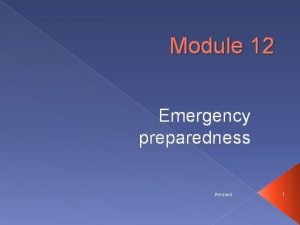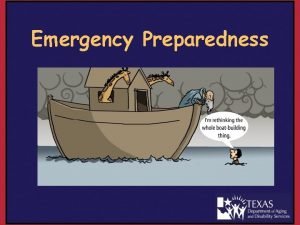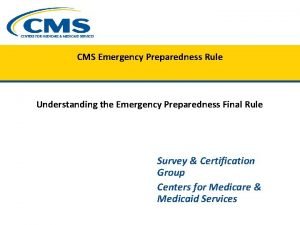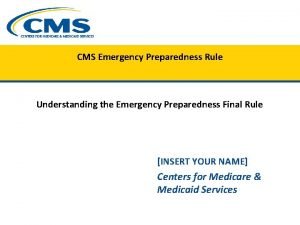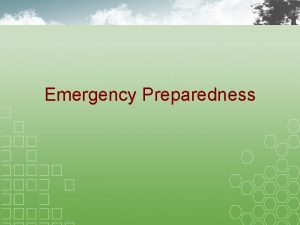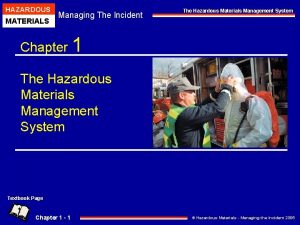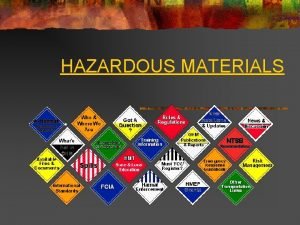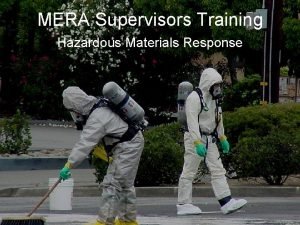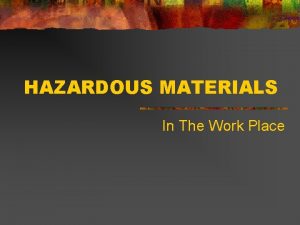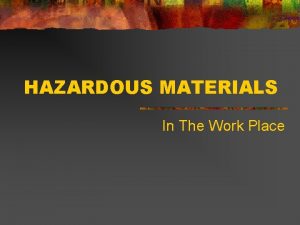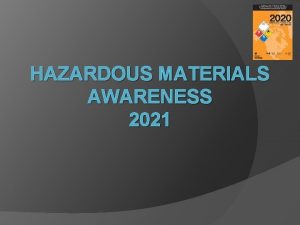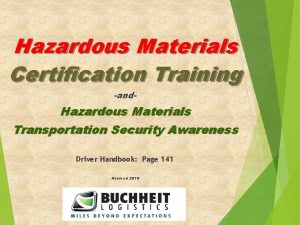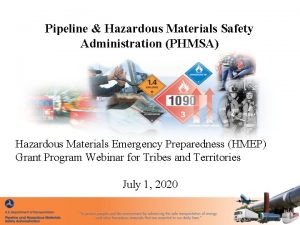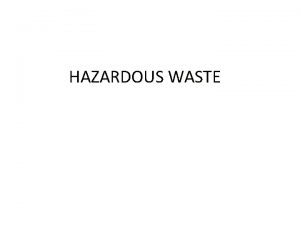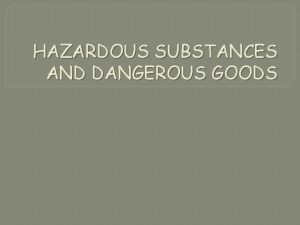Hazardous Materials Emergency Preparedness Grant Program States Territories


























































- Slides: 58

Hazardous Materials Emergency Preparedness Grant Program States & Territories Grant Application Development Webinar Performance Period: 2019 - 2022 -1 -

Agenda § § § Grants Chief Welcome HMEP Application Form Common Application Errors HMEP Grant Milestones Questions/Comments -2 -

Hazmat Grants Team Director Aaron Mitchell Chief Shakira Mack Senior Grants Management Specialist Carla Sheppard Acting Senior Program Analyst Andre White Grants Management Specialists Bonita Brown, Flor Valencia, Lisa Reichenbacher, Matthew Hufford, Nalita Viney, Suezett Edwards Program Support Rose Achieng – Business Analyst Kenetha Hillman – Administrative Assistant - 3 -

HMEP Formula Allocation Updates • New allocations will be based on updated risk-based data from PHMSA’s Incident database (2014 -2017). Grantees should expect to receive allocations for Year 1 as well as estimates for Year 2 and 3 during the week of February 18. • Allocation factors include (1) Incident frequency; (2) Average cost of incidents by transport mode (rail, water, air, highway); and (3) 2010 US Census state-level population density data. • To learn more about PHMSA’s Incident Data collection, please visit: https: //www. phmsa. dot. gov/hazmat-program-management-data-andstatistics/data-operations/incident-statistics -4 -

Components of the HMEP Grant Application 5

Components of the HMP Grant Application Initial (Year One) Application Your grant proposal must include the following: • Initial Application – Standard Forms • • SF 424 A Title VI ED-80 -0013 Certifications Regarding Lobbying; Debarment, Suspension etc. – HMEP Application Form • • • Part A: Grantee Information Part B: Transportation Fees Part C: Statement of Work Part D: Budget Narrative Part E: Certifications 6

Components of the HMEP Grant Application Continuing Applications (Y 2 & Y 3) Note: A continuing application is an application that provides updated information that was not provided in the initial application No certification forms, Governor’s letters, statements, etc. are required unless the designated agency has changed. Application should be much shorter! 7

Planning & Preparation Needs Assessment -8 -

Planning & Preparation Needs Assessment Why do we need a Needs Assessment? Needs Assessments play an active role in the accomplishment of organizational goals. They are used to identify strategic priorities, define results to be accomplished, guide decisions related to appropriate actions to be taken, establish evaluation criteria for making judgments of success, and inform the continual improvement of activities within organizations. -9 -

Planning & Preparation Hazmat Transport Needs Assessment Things to consider § Allow sufficient time to perform the needs assessment § Involve all parties needed § Determine if needs are feasible § Determine if needs coincide with the goals for your agency § Prioritize needs according to level of importance - 10 -

Planning & Preparation Hazmat Transport Needs Assessment 11

Planning & Preparation Hazmat Transport Needs Assessment 12

Planning & Preparation Hazmat Transport Needs Assessment 13

Components of the HMEP Grant Application Project Plan 14

Components of the Grant Application Overview There are 3 components to the HMEP Application: § Standard Forms • Application forms (SF-424, SF-424 A and Assurances) § Project Narrative (Project Plan) • Organization information (key contacts), needs assessment, goals and objectives, proposed activities to include the projected output and outcome of each, performance period timeline and a monitoring plan. § Budget Narrative • Describes and explains the costs listed in the SF-424 A, and demonstrates how match will be met. - 15 -

Components of the Grant Application Projecting Goals, Outputs & Outcomes § • • An objective goal is an overarching principle that guides decision making for the organization. • Specific • Measurable • Achievable • Realistic • Timely An output is the specific, measurable activity that will take place in the grant project. For example – completed 2 commodity flow studies. An outcome is a measurement and evaluation of an activity’s result against its intended or projected result. An example would be: the completion of 2 commodity flow studies identified several vulnerabilities in transport routes near a local college. - 16 -

Components of the Grant Application Listing Activities When listing activities in your project narrative, it is very important to remember the: Who –Who will be performing the task or activity? What –What task or activity is being performed? Why –Why is the task or activity being performed? Where –Where will the task or activity take place? When –When is the task or activity projected to be performed? How Many – What is the projected number participants involved in the task or activity? How Much – What is the projected cost of the task or activity? - 17 -

Components of the Grant Application Project Plan Activities The activities listed in the project plan speaks to the goals for the performance period and how you plan to implement and achieve them. Example: § Tula County, County a Sub-applicant of the State of Calisota is proposing to conduct a Hazmat Refresher course as a number of responders are now due for training § Training will be conducted at Tula Hazardous Materials College in Tula County. § Tula County is projecting to conduct a Hazmat Refresher course during the third quarter of the first year for maximum participation. § 57 participants are projected to attend this training course. The projected cost for this training course, to include travel, supplies, facility rental, and registration costs is $27, 571. 00. - 18 -

Components of the Grant Application Project Narrative – Timeline § A timeline is a metric which uses milestones upon which the grantee can monitor themselves for progress, as well as monitoring from PHMSA. § Project narratives must have timelines that indicate when activities will take place. 19

Components of the Grant Application Project Narrative: Guidance and Reminders § Review the HMEP funding announcement. § Do not copy and paste your project narrative from previous grant applications. § The project narrative must fully describe the proposed activities. “Subgrant process, TBD” is no longer valid. Applications that cannot describe how funds will be spent will be subject to Special Terms and Conditions. § Initial application should contain projections covering the 3 -year performance period. § Any revisions to the initial application can be made via a post award modification (activity request) or during the continuing application period. 20

Components of the HMEP Grant Application Budget & Budget Narrative 21

Components of the Grant Application Budget (SF-424 A) § A grant application must include a budget that details the costs required during the performance of the project. § The purpose of the line-item budget and budget narrative is to provide a forecast of expenditures and enable the actual financial operation of the organization to be measured against the forecast. 22

Components of the Grant Application Testing Your Budget An applicant’s budget request is reviewed for compliance with the governing cost principles, other requirements and policies applicable to the type of recipient and the type of award. The cost principles address four tests that PHMSA follows in determining cost eligibility. Costs charged to awards must be: § Allowable (2 CFR part 200, FOA, federal statute) § Allocable (2 CFR § 200. 405) § Necessary(2 CFR § 200. 403) § Reasonable and consistently applied (2 CFR § 200. 403) 23

Components of the Grant Application Budget Narrative, In-depth… The budget provides an overview of costs. The budget narrative is written to give a fuller explanation of the cost, and how it was calculated. The budget narrative of a grant proposal is important, as it provides: § Transparency for proposed costs listed in the SF-424 A Budget. § Justification for proposed costs that may appear questionable to the granting agency. § Details how and where the applicant will satisfy cost-sharing requirements (matching). - 24 -

Components of the Grant Application Budget and Budget Narrative Guidance and Reminders There is no 75% “pass-through” requirement, however, there remains a 75% programmatic requirement. At least 75% of the funds must be for programmatic activities, this includes: § Developing, improving, and implementing emergency plans § Conducting commodity flow studies § Conducting exercises § Training public sector employees 25

Proposal Budget and Budget Narrative • Up to 25% may be used for management and administration (“M&A”) of the HMEP grant such as monitoring and evaluating the program. • Other examples include: personnel and fringe costs for state employees involved with oversight of the grant, travel and supplies costs associated with monitoring the grant, and indirect costs. 26

Components of the Budget Narrative Budget & Budget Narrative SF-424 A Section A Enter the Federal and Non-Federal match amounts in their respective columns under New or Revised Budget. Column G should auto-populate. 27

Components of the Budget Narrative Budget & Budget Narrative SF-424 A Section B Enter the federal costs only. Planning and training should not be separated. Include matching amounts in this section (unless exempt). The budget narrative should be used to explain how matching will be met (if applicable). 28

Components of the Budget Narrative Budget & Budget Narrative SF-424 A Section C Enter the matching costs only. 29

Components of the Budget Narrative Budget & Budget Narrative SF-424 A Section D & E We encourage you to complete section D and E. 30

Components of the Budget Narrative Budget & Budget Narrative SF-424 A Section F is required if requesting indirect costs. 31

Components of the Grant Application Budget Line Items Explained Personnel (2 CFR § 200. 430) Employee salaries working directly on the grant project. Include the number, type of personnel, the percentage of time dedicated to the project, hourly wage, and total cost. § This category is limited to ONLY persons employed by your organization. Contractual and consultant costs should not be listed in the Personnel line item. 32

Components of the Grant Application Budget Line Items Explained Fringe Benefits (2 CFR § 200. 431) The allowances and services provided to employees as compensation in addition to regular salaries and wages. Include how the fringe benefit amount is calculated, a description of specific benefits charged to a project, and the benefit percentage. § Personnel and Fringe costs must be separated into their respective line-item categories. Do not combine these costs together! 33

Components of the Grant Application Budget Line Items Explained Travel (2 CFR § 200. 474) Those costs requested for field work or for travel to professional meetings. Provide the purpose, method of travel, number of persons traveling, number of days, and estimated cost for each trip. § If details of each trip are not known at the time of application submission, provide the basis for determining the amount requested. § Be sure not to exceed the Federal standard for rates of travel. Exceptions will be considered by PHMSA grant staff on the basis reasonableness and necessity. Federal rates of travel can be found on https: //www. gsa. gov/travel/plan-book/per-diem-rates 34

Components of the Grant Application Budget Line Items Explained Equipment (2 CFR § 200. 439) Includes those items which are tangible, nonexpendable, personal property having a useful life of more than one year and an acquisition cost of $5, 000 or more per unit (unless the state threshold is lower). § Include a description, quantity and unit price for all equipment. § If the expense is under the usual threshold of $5, 000 per item, it belongs under “Supplies. ” However, if your equipment threshold is below $5, 000, provide an explanation and state policy citation. § PHMSA recommends applicants have a plan in place to track and dispose equipment items acquired using HMEP grant funding in accordance with § 200. 313 (d)(e). §. 35

Components of the Grant Application Budget Line Items Explained Supplies (2 CFR § 200. 453) Tangible property other than equipment. Include the type of supply item in general terms. § It is not necessary to document office supplies in great detail (for example: reams of paper, boxes of paperclips, etc. ). A good way to document office supplies is to indicate the approximate expenditure of the unit as a whole. § However, applicants should include a quantity and unit cost for larger cost supply items such as computers and printers 36

Components of the Grant Application Budget Line Items Explained Contractual (2 CFR § 200. 22) Contractual costs are those services carried out by an individual or organization, other than the applicant, in the form of a procurement relationship. There are two ways to capture costs in this category: subgrants and contracts. What is a subgrant? (2 CFR § 200. 92; 2 CFR § 200. 330) An award provided by a pass-through entity to a subrecipient to carry out part of a Federal award received by the pass-through entity. § 1. Has its performance measured in relation to whether objectives of a Federal program were met. § 2. Responsibility for programmatic decision-making. 37

Components of the Grant Application Budget Line Items Explained What is a contract? (2 CFR § 200. 22) A contract is a legal instrument by which a Prime Grantee Recipient purchases property or services needed to carry out the project or program under an award. § Sub-awards and Contracts must be listed in the Contractual line-item category. In the budget narrative, they must be correctly identified as a sub-award or a contract. 38

Components of the Grant Application Budget Line Items Explained Other “Other” direct costs do not fit any of the aforementioned categories, such as rent for buildings used to conduct project activities, printing, utilities and/or leased equipment, employee training, tuition, etc. § “Other” direct costs should be itemized and the methodology explained in the budget narrative. 39

Components of the Grant Application Budget Line Items Explained Indirect Costs (2 CFR § 200. 416) Are incurred for common or joint objectives that benefit more than one project. The applicant must include a current and fully executed agreement in the application if claiming indirect costs. § Make sure the rate is applied to the appropriate base in the approved agreement. § If the rate will not be approved by the application due date, attach the letter of renewal or letter of request that you sent to your cognizant agency to your application. § Applicant may use the 10% De. Minis 40

Non-Federal Share Cost Sharing/Matching Cost sharing or matching is the portion of project costs not paid by Federal funds. For planning and training grants, this amount is 20%, if applicable. § On the 424 A budget, enter match in Section A, B, and C. In Section B, place the match in column 2. § Match must be fully described in the budget narrative in a clearly marked section for match. Explain the amount and how it will be met in the same manner you would for a federal share cost item.

Overall Budget Narrative: Reminders • Submitting a well-written budget narrative results in a faster review by PHMSA and a lower administrative burden to applicants. • Please check for computational errors! • Every number listed in the SF-424 A line-item budget should have a corresponding explanation as to how it was calculated in the budget narrative. 42

Things to Consider Recommendations § Applicants should endeavor to have the entire 3 -year activities detailed in the first year application. Continuation applications may simply be an update, or a statement that nothing has changed. § Start early! Identify sub-awards prior to application submission. Year’s 2 & 3 estimated funding is already known. § Steady progress throughout the grant period. Waiting until year 3 to complete activities is unacceptable and may result in a loss of funding. 43

Notice of Funding Opportunity (NOFO) The NOFO will provide the requirements for the continuing application submission (where to submit, format, etc. ). 44

Common Application Errors Did I Do That? 45

Most Common Application Errors Standard Forms 1. SF-424 – Application for Federal Assistance § § 2. SF-424 A – Budget Information § § § 3. Authorized Representative's Signature Listing Performance Period (3 Years for States/Territories) Failure to list only year 1 allocation amount Mathematical errors Failure to calculate budget items under the correct Object Class Missing, Incomplete, or Unsigned These Required Forms § § ED-80 -0013 – Certifications Regarding Lobbying; Debarment, Suspension, Drug-Free Workplace etc. Standard Title VI/Non-Discrimination Assurances – Civil Rights Assurances

Most Common Application Errors Project Narrative 1. Failure to identify Goals, Objectives, Outputs and Outcomes 2. Planning and Training Needs Assessment § Lack of identifying numerical data and substantiation for needed resource 3. Lack of clear outputs and outcomes 4. Exceeding 25% M&A threshold

Most Common Application Errors Project Narrative Cont. 1. Planning and Training Activities § Failure to align activities with budget narrative § Failure to provide a brief activity description with proposed output numbers and start/end dates § Failure to include estimated activity costs § Failure to correlate activities to goals, objectives and needs listed in the application

Most Common Application Errors Budget Narrative 1. 2. 3. 4. 5. 6. 7. SF-424 A budget failure to align with the budget narrative Lack of detailed explanation of how the agency will make its 20% match contribution (if applicable) Incorrect object class categorization enables mishandling of expenses or may cause postaward audit triggers Personnel/Fringe Benefit costs incorrectly charged Incorrect allocation of Indirect costs Identifying pass through indirect cost to the program Lack of indirect cost agreement/lack of clarity on inclusions causing duplicate expenses (direct vs. indirect)

HMEP Grant Milestones Mark Your Calendar! 50

HMEP Grant Milestones Application § § § FY 16 -19 Performance period ends: 09/30/2019 Application Period begins: March 2019 Application Due Date: April 30 (tentative) Application Award Date: 09/30/2019 Period of Performance: 09/30/2019 – 09/30/2022

Invitation to Apply PHMSA encourages all States and Territories to apply for the HMEP grant via www. grants. gov. - 52 -

Invitation to Apply Additional Requirements Additionally, applicants must register with Fed. Connect for an account before submitting an application. Your organization’s Marketing Partner ID number (MPIN), which can be retrieved from the System for Award Management (SAM), is required to create an account. For instructions on how to register in Fed. Connect and how to use the portal, view the Fed. Connect: Ready, Set, Go! Tutorial under the Need Help? section on the Fed. Connect home page. https: //www. fedconnect. net/Fed. Connect/Marketing/Documents/Fed. Connect_Ready_Set_Go. pdf Fed. Connect Instructions https: //www. fedconnect. net Fedconnect https: //www. sam. gov/SAM/ SAM 53

Hazmat Grant Program Contact Information General Grant Inquiries HMEP. Grants@dot. gov Website: www. phmsa. dot. gov/hazmat/grants Phone: (202)366 -1109 - 54 -

Questions? - 55 -

Q&A 1. Does PHMSA know the allocation amounts for all three years of the performance period? § Yes, PHMSA will provide all three years in the allocation email to the designated agency. Please be aware that the years two and three may vary slightly based on the sequestration. Also the allocation amount for year three may change if you receive an offset due lack of obligating all of your funds for year one. 2. Is there a way to receive additional funding? § Yes, through the offset process PHMSA used in FY 16 -19, a grantee could potentially be eligible to apply for supplemental funding for year three of the performance period.

Q&A 3. How do you know that you can claim indirect costs? § An applicant can claim indirect cost as long as the applicant has a valid Indirect Cost Rate Agreement (ICRA) from a Federal Agency. 4. Are subrecipients allowed to claim indirect costs? § Yes, as long as the subrecipient has a valid ICRA from a Federal Agency. 5. When will the information of supplemental funding available be provided? § PHMSA will provide information on supplemental funding during year three continuing application period so that those grantee that are eligible may apply for the additional funding.

Q&A 6. How does someone get on PHMSA Hazmat Grants mailing list? § To be added to our mailing list, please send an email requesting to be added to our distribution list. In your request make sure you provide the following information: name, job title, agency and state name, email, and phone number. 7. Are there any significant changes to the 2019 Expenditures Guide versus the 2017 version? § Yes, the food is no longer a conditionally allowable; it is unallowable. Also we have changed the Tier II Chemical Inventory Reports and Tier II Databases from unallowable to conditionally allowable. The Fire Rescue International (FRI) conference has changed from conditionally allowable to unallowable.
 Chapter 5 emergency preparedness injury game plan
Chapter 5 emergency preparedness injury game plan Chapter 36 emergency preparedness and protective practices
Chapter 36 emergency preparedness and protective practices Bsa emergency preparedness
Bsa emergency preparedness National radiological emergency preparedness conference
National radiological emergency preparedness conference Chapter 36 emergency preparedness and protective practices
Chapter 36 emergency preparedness and protective practices Stake emergency preparedness plan
Stake emergency preparedness plan Cms emergency preparedness rule
Cms emergency preparedness rule 29 states of india
29 states of india Uninhabited us territories
Uninhabited us territories Hazmat material table
Hazmat material table Hazardous materials table
Hazardous materials table Us military marking system for hazardous materials
Us military marking system for hazardous materials Pa-psfa-hazardous materials awareness
Pa-psfa-hazardous materials awareness Define whmis
Define whmis Isachmm
Isachmm Hazardous materials transportation act of 1975
Hazardous materials transportation act of 1975 Hazardous materials managing the incident
Hazardous materials managing the incident Hazardous materials reference books
Hazardous materials reference books Stanislaus county hazardous materials division
Stanislaus county hazardous materials division Pipeline and hazardous materials administration
Pipeline and hazardous materials administration Hazardous materials incident report
Hazardous materials incident report Hazardous materials business plan
Hazardous materials business plan Hazardous materials managing the incident
Hazardous materials managing the incident 29 cfr 1910 hazardous materials
29 cfr 1910 hazardous materials The mutcd states all workers
The mutcd states all workers India is divided into natural regions
India is divided into natural regions The colonial class system
The colonial class system Sales quotas and territories
Sales quotas and territories Powerful military lords who headed small territories
Powerful military lords who headed small territories Build up method of territory design
Build up method of territory design Designing territory
Designing territory Many territories and peoples controlled by one government
Many territories and peoples controlled by one government Chromosome territories
Chromosome territories Chromosome territories
Chromosome territories Spanish american war territories
Spanish american war territories What factors did you consider in acquiring territories?
What factors did you consider in acquiring territories? Westward expansion territories map
Westward expansion territories map Writing territories
Writing territories Function of sales executive
Function of sales executive Dog bite pictures
Dog bite pictures Shelby county office of preparedness
Shelby county office of preparedness 4 quadrants of operant conditioning
4 quadrants of operant conditioning Conditioning learning
Conditioning learning Conclusion
Conclusion Preparedness mitigation response recovery
Preparedness mitigation response recovery Biological preparedness
Biological preparedness Do. 27 s. 2015 promoting family earthquake preparedness
Do. 27 s. 2015 promoting family earthquake preparedness Data breach preparedness
Data breach preparedness 1achors
1achors West virginia center for threat preparedness
West virginia center for threat preparedness Who pip framework
Who pip framework Nfpa 1600 standard
Nfpa 1600 standard Hawaii disaster preparedness
Hawaii disaster preparedness Disaster management definition
Disaster management definition Nfpa business continuity
Nfpa business continuity 11 free states
11 free states Map of northern united states
Map of northern united states Tyranny
Tyranny Port security grant program
Port security grant program
